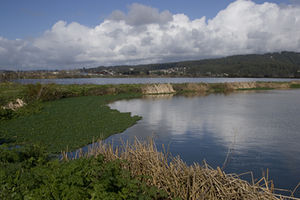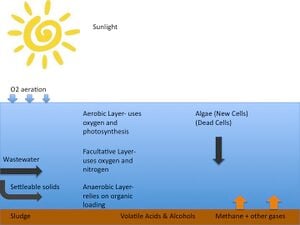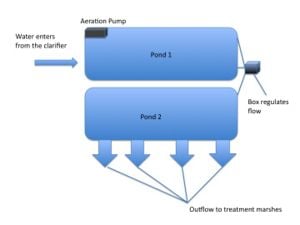
The Arcata Marsh and Wastewater Treatment Plant uses oxidation ponds as part of their secondary wastewater treatment process for wastewater. Primary wastewater treatment removes roughly 60% of the suspended solids. Secondary treatment speeds up natural processes of degradation by providing large amounts of oxygen to the wastewater. Oxidation ponds are generally more practical for smaller communities, such as Arcata, due to the large amount of space they require compared to other mechanical methods.
Advantages[edit | edit source]
- Less energy is used compared to other secondary treatment systems.
- They can degrade nitrogen and phosphorous, commonly found in fertilizers, soaps, and dishwashing detergents
Disadvantages[edit | edit source]
- The wastewater stays in treatment longer than other systems
- A large amount of space is required
- Potential for foul odors[1]
Types of oxidation ponds[edit | edit source]

- Aerobic Ponds- Aerobic ponds are generally shallow, less that 1 m deep, allowing sunlight to pass through to the bottom. The presence of sunlight in the entire depth ensures that algal photosynthesis is active throughout the entire system. During the day, the alga uses the sunlight, carbon dioxide, and inorganic material provided from bacteria to grow. In this process, the alga releases large amounts of oxygen into the ponds. Aeration with wind or mechanical aerators also can increase dissolved oxygen levels in the water. Aerobic bacteria break down organic suspended solid waste, and their metabolism uses the oxygen that the algae provides.
- Anaerobic Ponds - Anaerobic ponds function in the absence of oxygen, sunlight, and nitrogen and rely on organic loading rather than photosynthesis. The anaerobic process can be broken down into three steps.
- Hydrolysis- Anaerobic bacteria hydrolize complex waste to form their component subunits
- Acetogenesis- The component subunits are subject to fermentation and metabolic processes to form volatile acids and alcohols.
- Methane Fermentation- Anaerobic bacteria convert the end products to methane and other gases.
- Facultative Ponds- Facultative ponds (Figure 2) have an aerobic top portion, a facultative middle zone, and an anaerobic bottom. The facultative zone usually is aerobic during the daylight, and anaerobic during the night. Facultative bacteria can use oxygen to oxidize waste, but can also use nitrogen in the absence of oxygen.[2]
Arcata's Oxidation Ponds[edit | edit source]

Arcata's oxidation ponds function with the Arcata Marsh treatment wetlands as the secondary wastewater treatment. There are two separate ponds and the waste water flows through the following process (figure 3):
- Water enters from the clarifier on the east side of oxidation pond 1 with a BOD5 around 200 mg/L. The BOD is small and soluble at this point.
- A pump in pond 1 increases the dissolved oxygen and accelerates the anaerobic process and algae growth.
- BOD is broken down and the nutrients settle or are stored as algae.
- The wastewater flows throw pipes and a box that control the flow rate into pond 2 with a BOD5 reduced by 50%.
- Water flows from the side of pond 2 with a 33% BOD5 reduction into treatment marshes that kill and settle the algae. When the waste is released into the marshes, the BOD is large and in the algae.
Arcata's oxidation ponds are facultative ponds and they have several specifications:
- The ponds range from 2-3 meters in depth, having an aerobic top, anaerobic bottom, and a facultative middle zone.
- They cover 49 acres of space
- The volume of the ponds is generally around 88 million gallons
- In the summer dry season, receives about 1.5 million gallons per day. During the rainy season, the ponds receive approximately 2.3 million gallons per day. During severe storms, the ponds have received up to 17 million gallons per day. During periods of intense rainfall, excess water often skips primary treatment and goes straight to the oxidation ponds.
- Approximately 100 different types of algae grow in the oxidation ponds, but it's primarily green algae.
- Water typically stays in the oxidation ponds for up to 38 days.[3]